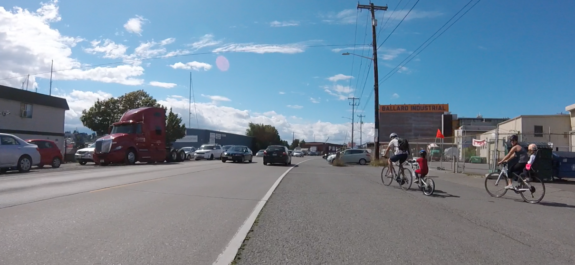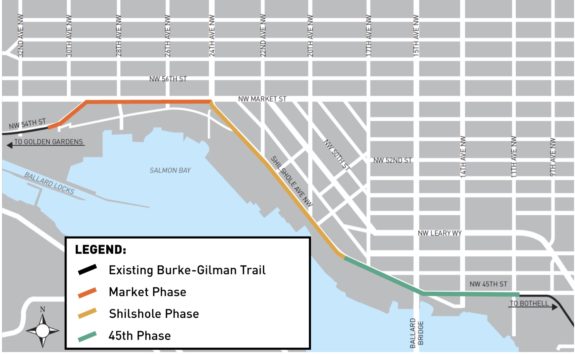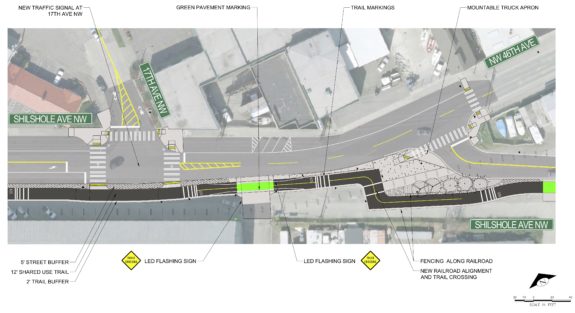Construction the Missing Link core scheduled to start this year + Latest economic study wades deep into the absurd

Why we need to build this trail.
After adding another 66 pages to the peak of the Ballard Missing Link's towering mountain of in-depth studies, Seattle is scheduled to start work on the core segment of the hard-fought trail this year.
Work is already underway on Market Street as part of a major road project that includes one third of the planned trail route as well as paving and transit improvements. That section, which more closely resembles a protected bike lane and complete streets project, was part of a big compromise deal former Mayor Ed Murray struck with industry leaders opposed to the initial route following the rail line between Shilshole Ave NW and the Locks.
Now the city has announced plans to begin work on Shilshole, perhaps the most controversial section of the project, after a court-required economic analysis (PDF) found, once again, that the project would not have an adverse impact on businesses. The additional study brings the total number of pages in just the final environmental impact study ("FEIS") to 895. For a trail.
 Work will now be broken into three phases. The Market Street phase is already under construction, the Shilshole phase is scheduled to begin this year and the NW 45th Street phase is scheduled to begin in 2020, My Ballard reports.
Work will now be broken into three phases. The Market Street phase is already under construction, the Shilshole phase is scheduled to begin this year and the NW 45th Street phase is scheduled to begin in 2020, My Ballard reports.
The 45th phase was separated from the Shilshole phase to consolidate all the work related to the rail line "while we continue to coordinate with Ballard Terminal Railroad," SDOT Spokesperson Ethan Bergerson told My Ballard. Even though that rail line is hardly ever used, Federal laws provide a lot of protections for rail corridors still in use. And "in use" can mean just a handful of trips per year. The Ballard Terminal Railroad has been an appellant to the project in court.
NW 45th Street already has a temporary bikeway installed on the street, though crashes where the bikeway crosses the railroad tracks under the Ballard Bridge have continued to injure people. The final design would place the trail on the south side of the street, and the rail crossing would happen at the south end of Shilshole rather than under the bridge. With fresh pavement and a more purposeful 90-degree crossing angle, the new crossing should be much safer. But this work requires the city to make small changes to the railroad alignment. Let's hope the BTR is not able to turn these small changes into another way to continue delaying a completed trail.
Economic study should finally put old arguments to restThe latest economic analysis is a somewhat absurd document because it sets out to answer questions that are barely relevant to this trail project or within the realm of the city's responsibility.
For example, one section tried to answer a persistent and baffling argument against the trail alleging that companies' insurance policies would increase because of the project. But after report authors interviewed many insurance professionals, they determined that "insurance premiums would not change based solely on the completion of the Missing Link because insurance companies do not use proximity to a multi-use trail as a risk factor."
Further, the authors found that "the possible economic impacts of potential risks from vehicle to bicycle/pedestrian traffic conflicts related to the Missing Link Project depend on two factors: the expected change in collisions and the assignment of fault." They also had to research the impact of companies choosing to hire flaggers for trail crossings, possibly due to insurance liability concerns. The authors then state the obvious about the role of the trail project in these factors:
- "We anticipate that completing the trail would lower the probability of collisions compared to existing conditions." Because that's the whole point of this project!
- "Various laws and codes regulate the behavior of all the potentially at-fault parties and failure to comply may weigh towards a presumption of fault, but no law predetermines fault for collisions between vehicles and bicyclists or pedestrians." Don't break the law, and you won't be found at fault for a collision. That seems pretty straight forward.
- "There is no legal requirement for businesses to employ flaggers and/or spotters in response to the existence and normal operation of the BGT Missing Link." Some businesses may choose to hire flaggers, and the study went into detail on how much these imaginary flaggers might get paid. But that's the business's choice. Trail crossings will be crosswalks like any other trail crossing, and there are many trails in town that professional drivers cross without flaggers. And, again, a business's choice to hire flaggers is barely relevant to the city's decision about whether to build this trail.
The study also found that insurance rates for companies along the route have already been increasing in recent years for a multitude of reasons that have nothing to do with this trail project. If there were a scenario in which insurance rates got too high for the businesses to operate, the trail would not be the reason.
But all of this should have been irrelevant to this study to begin with, as the authors note: "SEPA procedural provisions require the 'consideration of 'environmental' impacts" that are likely, not merely speculative.'" The idea that a trail project team should even need to research potential insurance rate changes for businesses due to purely speculative collisions in which the professional drivers broke a law and are found at fault is just ridiculous. But this project blew past the phase of ridiculous long ago.
The authors also addressed a number of other random and sometimes bizarre concerns from businesses. "Some businesses and trade group representatives asserted that the psychological toll of the difficult operating environment will cause some businesses to move," the authors wrote. I don't even know where to begin with this one. You're telling me that a business might find the existence of a biking and walking trail so psychologically troubling that they would have to move? I can't even. But the authors do a good job of handling it professionally, writing:
"from an economic standpoint, we must assume that there is some financial benefit to operating out of their current locations or they would relocate. Attributing any relocation to psychological factors that are not fiscally motivated is inherently not an economic issue and outside the bounds of this analysis."
And though the authors don't go into it, if you want to talk about psychological tolls, let's talk about the enduring trauma of people who have been and continue to be injured while biking through the Missing Link. GTFO.
We've clearly run out of things to argue about here. Time to build it and move on.
